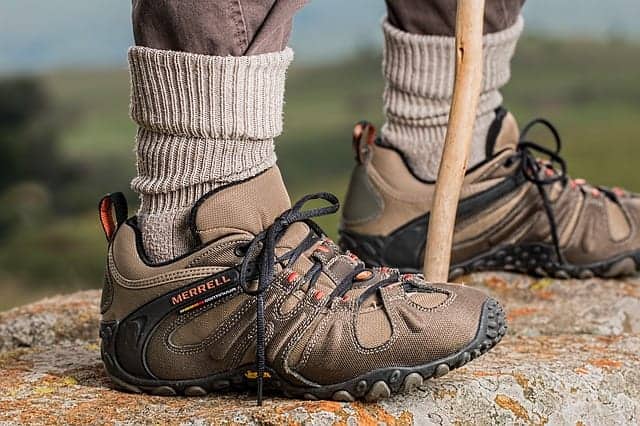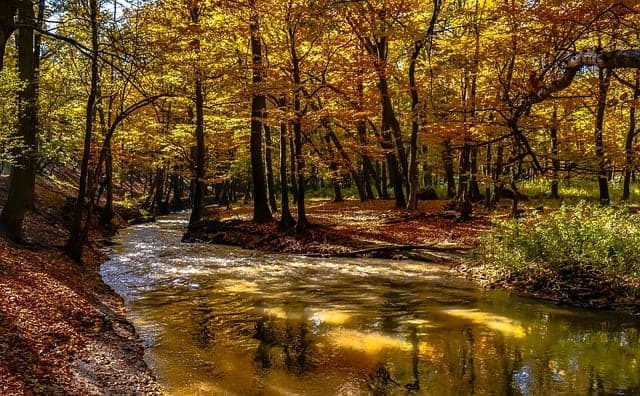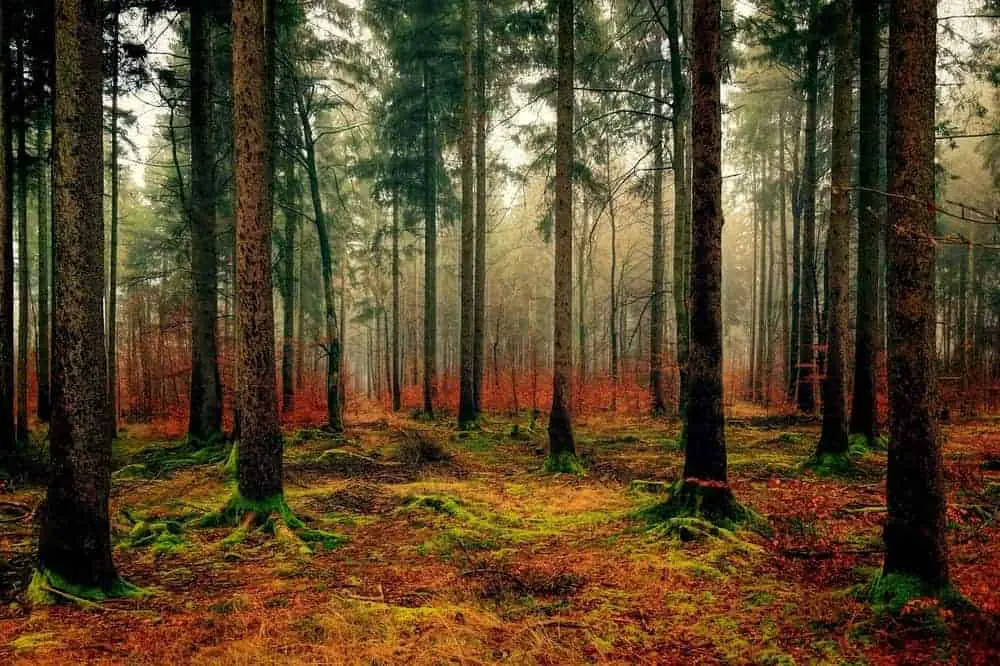How To Hike In The Woods, Stay Safe, And Utterly Enjoy It
Do you dream of having an exciting outing among the mesmerizing beauty of the green forest?
Then you should definitely learn how to hike in the woods so you take the most out of the experience. In fact, there are some rules to follow that will make that experience unique in a positive way. Hiking in the woods has its particularities. It’s slightly different from walking on mountain trails or road trekking.
There are factors to consider that will define your preparation and planning. For instance, you should think about the climate, the vegetation, and the wildlife. And that’s just for starters.
In this article, I will show you some practical tips that I’m sure will come in handy anytime you decide to take a day walk deep in the woods. I am a big forest lover and I like to walk among the greenery for hours, sometimes for days. I’m sure you’ll agree that it’s like entering a temple.
Without further ado, let’s get ourselves rolling. Are you already feeling the smell of the trees?
What’s Different When Hiking In The Woods?
Let’s begin with something that you can't overlook.
The Climate
The climate in the woods differs from those in other locations. According to the renowned educational website Kids Do Ecology, the weather averages in deciduous forests are 10 ℃. During even the hottest summer, the temperatures are rarely above 21℃. Yes, forests are cooler than open fields.
On one hand, that’s because of the evapotranspiration. A factor for this phenomenon are the trees. They are able to transfer water from the ground to the atmosphere by the means of transpiration. Shorter, shallow vegetation simply cannot realize this process as effectively. That’s why in forests the air’s so humid.

Image via M. W. Toews.
On another hand, the ground in the woods is more shaded. And that’s because of the thick vegetation and the dense crowns of the trees. It’s difficult for the sunrays to reach beyond the many branches and leaves.
To summarize, in forests it’s cooler and humid when compared to other spaces.
All that requires careful consideration of the gear you will bring. More on that later.
The Wildlife
Have you watched the latest Jurassic Park movie? If yes, then you know the kind of dangerous species you may encounter in the woods. Jokes aside, the animal inhabitants in the woods are not to be underestimated, even though they are not as deadly as some prehistoric creatures.

This bear is cute. His mother may not be if she sees you.
I am talking about the bears, the wolves and the snakes. You just can’t overlook them so you must know what to do if you happen to meet some of them. Also, don’t forget the insects – the ones you should be worried about are ticks, bees, mosquitos, and asps.
The Vegetation
That’s something obvious but I need to mention it. Plants in forests differ from those in other places.
There are species that can hurt you and in rare occasions even cause fatalities, especially when you eat them.
For instance, we all know how painful could be the nettle burn. You need to learn to recognize this herb so you can avoid it because it stings.
A popular mistake that mostly kids make is eating Rosary Pea. It looks sweet and delicious just as red berry but it can kill you because it contains the toxic compound abrin.
Another plant that can severely irritate your skin (if not worse) is the infamous Poison Ivy.

Nettle soup is delicious. The plant can burn you badly.
The bottom line is – don’t eat plants of any kind in the woods and avoid touching them unless you really know what you are doing.
After considering all the above differences between hiking in the forest and hiking everywhere else, I think you know why you should keep those in mind. These differences will have a direct impact on the most important stuff – the equipment you need to choose.
How To Properly Gear Up For Hiking In Forests?
Undoubtedly, walking in nature has a plethora of benefits, even if you suffer from bad knees.
However, to fully enjoy your outdoor adventure and stay safe and comfortable, you need to have the proper gear. This is especially true when you walk in the woods.
What should you bring on such a hike?
I recommend you always refer to a very useful guide known as The Ten Essentials. It contains a list of mandatory survival items you need to have when out in the wilderness.
In the video below, expert Paul Kirtley explains what items you can't neglect when you pack for a day walk in the woods. Check it out.

In addition, let’s check in detail some important items you should take with you. These are the things I often pack too.
What Kind Of Shoes To Wear In The Woods?
When you walk in the forest, you need light shoes. They must have cushioned midsole and good traction in muddy or slick conditions.
A good idea is to choose trail runners.
They are typically lightweight and comfortable.
My advice would be to avoid hiking boots. They tend to be heavy and may induce blisters when you walk extensively. Still, check our guide here on how to make hiking boots more comfy.
They might provide extra support for the ankle and general stability when you walk on mountain trails but in the woods, they are not as efficient.
Sure enough, it all depends on the type of terrain. If you are planning to go really wild and cross rivers or streams, you might need taller boots with decent water insulation. Plus, boots doesn't have to be heavy.
There are tons of good boots that are both sturdy and lightweight. Typically, Salomon and Merrell make great boots that fit the above criteria but there are many others as well.

Always choose lightweight walking shoes with good traction and water insulation instead of heavy hiking boots.
Another type of shoes you should not wear are sandals. They surely have their advantages (just check out our Viakix sandals review), but the last thing you want in a bushy forest is an open-toe shoe.
Imagine what would happen when you have to cross a small stream, flounder in mud or walk on prickly vegetation.
Some folks prefer steel toe shoes. They are protective but quite heavy. Keep that in mind.
How To Choose The Right Backpack?
If you are going for a day or two you should aim for a backpack that is not more than 50 L in volume. My suggestion is to strive for ultralight backpacking. You feel the weight on your back heavier with every additional mile.
The perfect backpack would be easy to organize, spacious and with enough compartments and pockets. The most important thing is to fit close to your body. Otherwise, it may become quite uncomfortable and you may hurt your spine and shoulders.
It’s always good to have a sturdy, water resistant backpack, made of strong fabric such as 500D or 600D PVC. If downfall pours, I suggest you bring a rain cover. Many backpacks have it integrated.
You might want to check out this list of the best lightweight backpacks or this list of the top-rated packs for hiking.
Gear For Protecting Yourself From Animals And Insects
No matter how rare you think it is to get into a dangerous situation involving an animal, it might happen.
It’s recommended to avoid such areas and to do everything in your power to hide yourself and stay away from wild animals. However, you’d want to be prepared. Here’s some useful stuff that may help.
Bear Spray
Contrary to many opinions you may hear, pepper sprays do work. It might not be as efficient as a gun but it’s much better than to have nothing to protect yourself with. The main ingredient is capsaicin. Such sprays usually work on other animals as well such as wolves or coyotes.

Don’t hesitate to use bear spray if you need to.
That’s because they are harmful to any creature that has eyeballs, sinuses, and soft tissue. You can find such products in outdoor outlets and on Amazon.
Insect Repellents
There are protective lotions you can use to moisturize your skin prior to walking in the woods. They are very good against bites.
Be careful to choose the ones proven to work because there are various cheap options on the market that will harm you instead of protect you. That’s why always read the label because the ingredients are what matters most.
The high quality repellents contain picaridin, deet, and lemon eucalyptus oil.
Apply such chemicals only on exposed skin and never on wounds.

Apply insect repellents on your skin and clothes when walking in bushy areas.
Be especially aware of the danger that ticks present. Those nasty bugs carry various diseases such as Lyme disease, babesia, and enrlichia.
You don’t know what these mean? Believe, me you don’t want to. Besides using repellents, frequently inspect your body, especially if you walk on bushy areas.
How To Protect Yourself From Snakes?
Aaaargh…Snake!
That’s what my wife usually screams when she sees a snake. I understand her. Snakes are not pleasant.
However, many people don’t know that in most of the cases they are not aggressive. Moreover, they will first try to hide and sneak out instead of chasing you.

Snakes are not agressive creatures.
With that being said, keep in mind snakes are active at nights and in warm weather. The most important thing you can do if you see a snake is to stay calm and don’t panic.
Watch your feet, wear long pants and covered shoes. Avoid passing through places with thick bushes where you can’t see anything that’s on the ground.
If you happen to be bitten by a snake, keep your cool, allow the blood to spill for 30-40 seconds, and don’t make a tourniquet. It won’t help for removing the venom and it might hurt the skin tissue even more.
Pro Tip: an effective repellent is “Ortho Snake B Gon”. If you have settled for camping for a while, sprinkle the area around with it. It will keep the snakes away.
What About Firearms?
Sometimes you may want to go deep in the wilderness while being aware of the presence of aggressive wild animals. In such cases, if you are legally authorized to carry and use a weapon, bring it.

Be careful if you bring a gun and always check the local law.
Be careful, though and check whether it is allowed for use in the specific area where you’re going. Don’t play Rambo without checking the laws because that could get you in serious trouble.
5 Other Must-Have Items You Can’t Miss
I’ll briefly mention some other necessities to consider taking with you when hiking in the woods. Enough water and food are not included since this is something you should bring by default.
An important tool to pack if you love to hike in winter is a backpacking snow shovel.
How Not To Get Lost In The Woods
Based on a recent statistic, more than 2000 people get lost in the woods every year.
Often, the forest surroundings are unvaried. It’s full of greenery and similar paths everywhere. That’s why start by planning your itinerary wisely.
Research it well, especially if you are hiking solo. Check it online, read reviews, and thoroughly follow it on the map. Most importantly – don’t set an unachievable goal.
Know your limits and don’t get carried away by your adventurous spirit.

Don’t loose your cool if you get lost. Think and act.
Probably you are familiar with that sense of wild curiosity, which makes you want to explore what lies behind the upcoming hill.
And after that, you want to continue and continue, haunted by the beauty of nature. Don’t take unnecessary risks you are not prepared for and know when to stop.
Avoid following unmarked trails unless you have some experience behind your back. Keep in mind that some trails or paths exist because wild animals made them.
They will lead you nowhere. Don’t hesitate to get a guide if that will ease your mind.
Besides being wary, you must possess the right gear. Let’s see what I’m talking about:
What To Do If You Get Lost Anyway?
As with the snakes, don’t panic. You need to do some sober thinking. If you can go back to a familiar place, which is not far away from your current position - do it. Give yourself some time to remember how you get to your present location. Where did you pass through? What distinctive landscapes or objects did you see?

Try to find running water and start walking along its direction.
Try to find a high hill or a rock that you can safely climb. Being on higher ground will give you a better view of the surroundings.
You will be able to see any rivers or roads if any. Observe carefully because you might see traces of people or any kind of civilization.
If you find a river or a stream, walk along the water direction. It will most probably lead you to a populated place.
If you are wondering which direction to take, it’s a good choice to start walking downhill. It’s less tiring and chances are you will bump into other people or signs of civilization.
Village people tend to settle down close to water and in valleys. Don’t hesitate to blow your whistle and hopefully someone will hear you.

Use your GPS, map or compass to find a way out if possible. If not, know that moss grows on the north side of the trees. That will give you a starting point. If the situation is out of control, call emergency services and follow their instructions.
Pro Tip: learn how to make a signal fire that can be seen from faraway distances. Here’s a good guide.
Set Your Mind To Fully Enjoy The Adventure
That what hiking in the woods is – an invigorating adventure. Forget about your everyday problems and dive into the experience with your entire body, mind, and soul. After all, you deserve this. Don’t let anything distract you.
Forget about social media, all the town hustle, and the issues of others. Be open-minded, put a large smile on your face, and start exploring nature. This is your time and your time only.

Forget about your city life and have fun!
Listen to the sounds, be aware of the smells, and immerse yourself in the environment. Remember what I said in the beginning – walking in the woods is like entering a temple. Don’t forget that.
Conclusion
Hiking in the forest is one of the best hikes you can take. It’s so different and stirring. Still, there are some rules to follow that will make your expedition perfectly safe and utterly enjoyable. Remember to gear up well and to think about every imaginable obstacle you may encounter. Don’t forget the differences in the climate, the wildlife, and the items you need.
Gain some basic orientation skills and arm yourself with a positive attitude. I promise you, this could turn into the best time of your life.
Thank you for reading this guide. I hope it will serve you well. I stop now, because I don’t want to continue writing. I desperately wanna hike!
Where was your last trip into the woods? Share your experience in the comments below!
Asen Stoyanchev
Founder of this website, Asen is a passionate hiker and writer who is also a gear nerd. He’s been featured on many established hiking websites where he gives hiking advice & tips. When he is not trekking with his family or friends, he is writing articles and product reviews. Asen spends most of his time in Bulgaria but he constantly travels the world in seek of more unforgettable experiences. Read more about Asen here.




